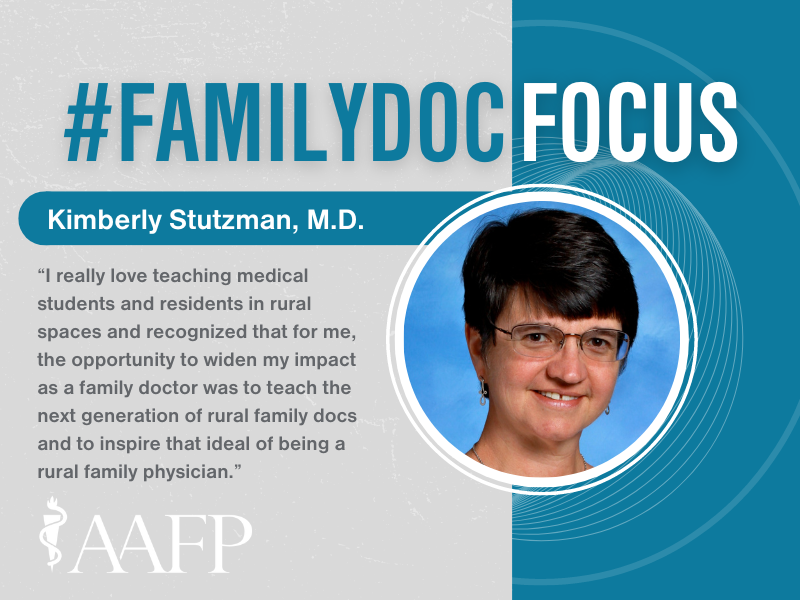Showing Residents the Ideal of Rural Family Medicine
Dec. 14, 3:22 p.m. David Mitchell — Kimberly Stutzman, M.D., had been out of residency for more than a decade when she decided to move her career in a different direction. She left her practice in rural Washington and moved her young family more than 350 miles southeast to Boise, Idaho.

The move from tiny White Salmon, Wash., (population 2,200) wasn’t made to get away from rural practice but rather to share her passion for it with future family physicians.
“I really love teaching medical students and residents in rural spaces and recognized that for me, the opportunity to widen my impact as a family doctor was to teach the next generation of rural family docs and to inspire that ideal of being a rural family physician,” said Stutzman, who has held faculty appointments in the University of Washington’s Department of Family Medicine since 1995. “For family medicine, that’s really where you get to utilize all the skills that you’re taught in residency.”
Stutzman joined Full Circle Health’s Family Medicine Residency of Idaho in 2007 and has been program director of its Nampa residency — one of four family medicine residencies in the health system — since 2018. The Nampa program, which has six residents per class, prepares residents for the full-spectrum care needed in rural and underserved communities, including an emphasis on procedures as well as in-patient and emergency care.
Stutzman was exposed to small-town family medicine early in life. Her stepfather, Richard Knecht, M.D., practiced in Petoskey, Mich., a small resort community on the northern shores of Lake Michigan.
“He was obviously a big inspiration to me,” she said. “We grew up in a town of 5,000. Watching him give back to the community over and over again was pretty compelling.”
Stutzman’s pivot to an academic setting required additional training, and she completed three fellowships in nine years: the University of Washington’s Faculty Development Fellowship; the Society of Teachers of Family Medicine’s Emerging Leaders Fellowship; and the Association of Family Medicine Residency Directors’ National Institute for Program Director Development.
“Working in a standard family medicine practice is very different and utilizes different skills than being a residency director or faculty, so getting that fellowship training can really help you be successful,” she said. “I think that extra knowledge is really helpful to improve your leadership skills.”
Stutzman has brought her leadership skills to numerous local, state and national positions, and to her role as president of the AFMRD. That organization will have its annual meeting March 4 in Kansas City, Mo., to coincide with the AAFP’s Residency Leadership Summit, which is March 3-5.
Stutzman will present a session for new program directors during the summit, along with AFMRD President-elect Kristina Diaz, M.D., M.B.A, the director of the family medicine program at Yuma Regional Medical Center in Yuma, Ariz.; and Deb Clements, M.D., chair of Family and Community Medicine at Northwestern University’s Feinberg School of Medicine and director of its family medicine residency at Lake Forest, Ill.
The Residency Leadership Summit will offer program directors, coordinators and faculty information on a wide variety of topics, including the new Accreditation Council for Graduate Medical Education program requirements that will take effect July 1, 2023.
Stutzman said one of the most important things attendees will take away from the conference is connections.
“The job of a program director can feel really lonely because usually you’re the only one,” she said, “so being in a room full of other program directors is amazingly helpful for learning, developing, making connections and fellowship. I really think that it’s an opportunity to just meet other people dealing with similar problems.”
Before becoming program director at Nampa, Stutzman was the director of Full Circle Health’s residency in Caldwell, Idaho, for two years. That program, which originated as a rural training track with one resident in 1995, has slowly expanded to accept three residents per year. Nearly 90% of its graduates practice in rural areas.
“I went into leadership because I was at a relatively new, small program,” said Stutzman, who has served on the AFMRD Board of Directors for seven years. “I was really focused on rural training, and I saw this as an opportunity to have that voice be heard and to understand what’s happening on a national level. The people that you meet and the other leaders that you get to interact with are amazing.
“It’s also an opportunity to serve my fellow program directors. I really believe that all of us do this work out of a certain amount of service. For lack of a better term, it’s my turn. I’ve received so much benefit from the family of family medicine — the fellowship, the camaraderie, the opportunity to grow the next generation of folks who will care for my kids as they age.”
More than 15 years after she left Washington, Stutzman still returns to visit friends in White Salmon, which still feels like home. But she has few regrets. Her advice to others pondering a career in academic medicine after working in a more traditional family medicine practice?
“Do it,” she said. “There is so much value in having on-the-job experience and sharing that with residents to help prepare them for real-world experiences. Folks who come back to teaching bring so much to the table.”